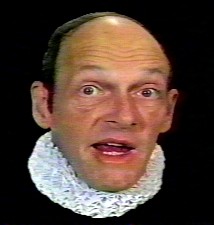Jerry Hunt was an Texas-based composer of electronic music whose interest in the occult had a large influence on his work. He was born in 1943 and died by his own hand in 1993.
According to Michael Schell’s article” Unlikely Persona: Jerry Hunt (1943-1993)” which appeared in Musicworks #65:
“In his compositions, Jerry applied his extensive knowledge of mystical systems, particularly those of alchemy, Goëtic theurgy, Tarot, voodoo and Kabbala. Jerry’s favorite occultist was the Englishman John Dee. An accomplished mathematician and astrologer, Dee is best known for transcribing a series of seances held between 1582 and 1589, in which his medium, Edward Kelley, purports to hold conversations with contacted spirits, chiefly the angel Uriel. The centerpiece of the transcriptions is the Enochian tablets (pictured at right), several tables of letters and numbers resembling giant bingo cards, formed from the names of Gabriel, Enoch and other angels well known to 16th Century Kabbalists. New angelic names, and their associated signatures or sigils, could be formed by reading across the tables. More complicated rules of derivation were used to divine new angelic names as well as a secret angelic language with its own 21-character alphabet.
“Using the Enochian tablets, Jerry created a ground core, something he cryptically described as “a system device of translation gestures [that] provides a string of goals which becomes coherent through reiterative additive uses”. This in turn was used to compose several works, including those featured on his 1992 CD Ground: Five Mechanic Convention Streams (see Jerry Hunt: recorded works). A good introduction to his recorded music, the five works on this CD feature his usual sampled instruments — mostly bowed string and percussion — as well as a variety of acoustic sources: pianos, whistles and rattles, a violin played by Jane Henry using different kinds of conventional and unconventional bows, and two male speaking voices (Jerry’s and Rod Stasick’s). All of the works share a fast pace, certain rhythmic characteristics, and an emphasis on irregular instrumental trills and tremolos. Jerry disliked repetition and sustained notes, and his musical details constantly change within a static, non-episodic overall structure of generally constant density and tempo.” (read the entire piece here: http://www.jerryhunt.org/huntmus.htm)
Recordings of some of Hunt’s work are available on CD from Forced Exposure who note:
“..The sounds on this recording, created in 1993, are completely different from the ones that constitute normal or academic electronic music. The three sections of this electronic work constitute the composer’s last pieces. He regarded the recorded version of this work as a ‘document for rehearing.’ The overall sound is the densest and most intricate in this one of a kind artist’s body of work…”
The CD in question is avaiable for purchase via: http://www.forcedexposure.com/Catalog/hunt-jerry-haramand-plane-cd/POGUS.21069.html
Vocalist/percussionist Amy Neuburg will be perform some of Hunt’s work in Germany this March (details here: http://www.amyxneuburg.com/shows/) and Reinier van Houdt performed an interpretation of one of Hunt’s works in concert at Wesleyan University last year. (details here: http://www.wesleyan.edu/cfa/events/2014/09-2014/09042014reinier-van-houdt.html)
http://www.jerryhunt.org/ is a site memorizing Hunt’s life and work.
Thanks to Soror Hypatia for the tip and several crucial links!


